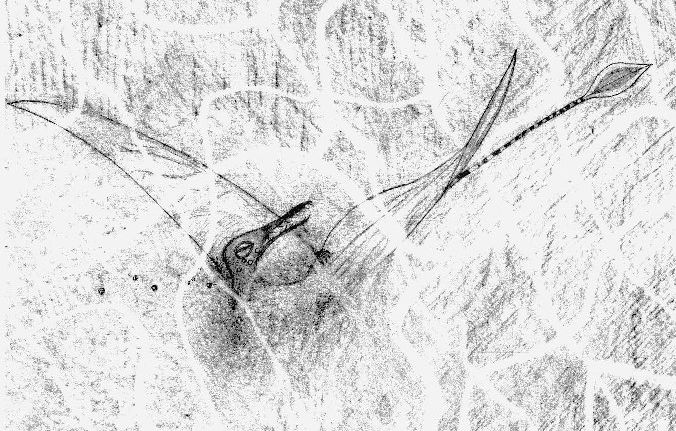ShopDreamUp AI ArtDreamUp
Deviation Actions
Suggested Deviants
Suggested Collections
You Might Like…
Description
I drew this pterosaur from a fossil here:[link] Rhamphorhynchus "Beak Snout" on the bottom of a pond. It was a pterosaur, a flying reptile closely related to the dinosaurs. It lived during the late Jurassic period, roughly 150 million years ago.
ANATOMY:
Rhamphorhynchus had a small body, short legs, and large, light-weight wings. It had a diamond-shaped flap of skin at the end of its long, thin, pointed tail; this flap helped stabilize it in the air. It had long, narrow jaws with sharp teeth that pointed outwards. Rhamphorhynchus had a 5.75 foot (1.75 m) wing span and a skull 7.5 inches (19 cm) long.
DIET
Rhamphorhynchus was a carnivore (a meat-eater) and probably ate fish.
LOCOMOTION
Rhamphorhynchus flew well using large, light-weight wings. Its long tail with a diamond-shaped flap of skin at the end helped stabilize it in flight. Its tiny legs probably made Rhamphorhynchus a poor runner.
CLASSIFICATION
Rhamphorhynchus was a pterosaur, a flying reptile closely related to the dinosaurs. By definition, all dinosaurs were diapsid reptiles with an upright stance. Pterosaurs probably had a semi-upright stance, and were not dinosaurs. There is a small minority of paleontologists who think that the pterosaurs' stance could have been upright and that pterosaurs should therefore be included in the clade of dinosaurs (being derived theropods). Either way, dinosaurs and pterosaurs are certainly closely related.
Rhamphorhynchus was a:
Vertebrate
Tetrapod
Diapsid - these include all the reptiles (except turtles) and birds. They are distinguished by having two holes in the rear upper part of their skulls and two holes behind the eyes.
Archosaur - this group includes dinosaurs, crocodilians, pterosaurs, birds, etc.
Pterosaur - flying reptile, including Dimorphodontids, Anurognathids, Scaphognathidae, Rhamphorhynchid, Protopterodactyloids, Pterodactyloids, Dsungaripterids, etc.
Rhamphorhynchoid ("prow beaks") - early pterosaurs that appeared during the Triassic period and went extinct at the end of the Jurassic, that had protruding teeth in pointed jaw, long tail, short neck, and long, narrow wings. These were among the first flying vertebrates and probably flapped their wings to fly. These include Eudipmophodon, Camplognathoides, Rhamphorhynchus, and Dorygnathus.
Genus Rhamphorhyncus
Species include:
R. gemmingi, with the sharpest snout
R. longiceps, the largest
R. intermedius (perhaps a juvenile R. longiceps) and others.
Rhamphorhynchus was named in 1847 by paleontologist Hermann von Meyer. Fossils have been found in Solnhofen, Germany, and Tanzania, Africa.
Text credit to:
ZoomDinosaurs.com
Dinosaur and Paleontology Dictionary
Drawn by Brian Roesch on 07-06-2005.
ANATOMY:
Rhamphorhynchus had a small body, short legs, and large, light-weight wings. It had a diamond-shaped flap of skin at the end of its long, thin, pointed tail; this flap helped stabilize it in the air. It had long, narrow jaws with sharp teeth that pointed outwards. Rhamphorhynchus had a 5.75 foot (1.75 m) wing span and a skull 7.5 inches (19 cm) long.
DIET
Rhamphorhynchus was a carnivore (a meat-eater) and probably ate fish.
LOCOMOTION
Rhamphorhynchus flew well using large, light-weight wings. Its long tail with a diamond-shaped flap of skin at the end helped stabilize it in flight. Its tiny legs probably made Rhamphorhynchus a poor runner.
CLASSIFICATION
Rhamphorhynchus was a pterosaur, a flying reptile closely related to the dinosaurs. By definition, all dinosaurs were diapsid reptiles with an upright stance. Pterosaurs probably had a semi-upright stance, and were not dinosaurs. There is a small minority of paleontologists who think that the pterosaurs' stance could have been upright and that pterosaurs should therefore be included in the clade of dinosaurs (being derived theropods). Either way, dinosaurs and pterosaurs are certainly closely related.
Rhamphorhynchus was a:
Vertebrate
Tetrapod
Diapsid - these include all the reptiles (except turtles) and birds. They are distinguished by having two holes in the rear upper part of their skulls and two holes behind the eyes.
Archosaur - this group includes dinosaurs, crocodilians, pterosaurs, birds, etc.
Pterosaur - flying reptile, including Dimorphodontids, Anurognathids, Scaphognathidae, Rhamphorhynchid, Protopterodactyloids, Pterodactyloids, Dsungaripterids, etc.
Rhamphorhynchoid ("prow beaks") - early pterosaurs that appeared during the Triassic period and went extinct at the end of the Jurassic, that had protruding teeth in pointed jaw, long tail, short neck, and long, narrow wings. These were among the first flying vertebrates and probably flapped their wings to fly. These include Eudipmophodon, Camplognathoides, Rhamphorhynchus, and Dorygnathus.
Genus Rhamphorhyncus
Species include:
R. gemmingi, with the sharpest snout
R. longiceps, the largest
R. intermedius (perhaps a juvenile R. longiceps) and others.
Rhamphorhynchus was named in 1847 by paleontologist Hermann von Meyer. Fossils have been found in Solnhofen, Germany, and Tanzania, Africa.
Text credit to:
ZoomDinosaurs.com
Dinosaur and Paleontology Dictionary
Drawn by Brian Roesch on 07-06-2005.
Image size
676x431px 103.54 KB
© 2005 - 2024 briankroesch
Comments6
Join the community to add your comment. Already a deviant? Log In
Nice--well I WAS going to say resurrection, but that doesn't quite work, does it?--fleshing out of the fossil. This one just happens to be one of my favourite Rhamphorhychus specimens. The fossil is so beautiful layed out like it is on the slab. You've given us a beautiful glimpse of it just before burial. Very nice.



















![[Pterraforming] Red Throated Titanodactyl](https://images-wixmp-ed30a86b8c4ca887773594c2.wixmp.com/f/3955c483-e42e-4fef-9f1e-d9a0b9fe5c4f/d9jdhod-5e99feb2-9a47-442f-91ac-3a59e839f1d8.png/v1/crop/w_184)
















